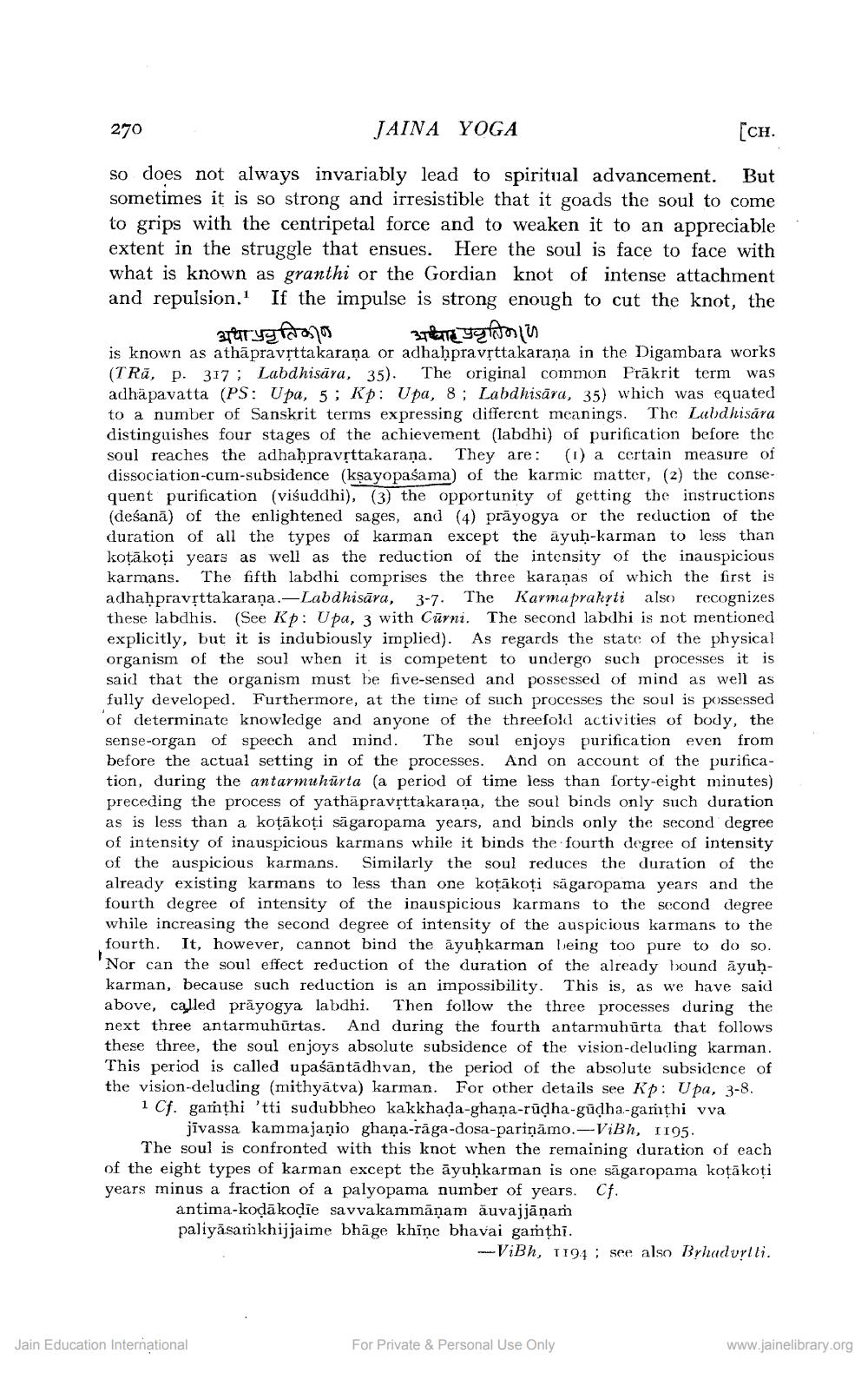________________
270
JAINA YOGA
But
so does not always invariably lead to spiritual advancement. sometimes it is so strong and irresistible that it goads the soul to come to grips with the centripetal force and to weaken it to an appreciable extent in the struggle that ensues. Here the soul is face to face with what is known as granthi or the Gordian knot of intense attachment and repulsion.1 If the impulse is strong enough to cut the knot, the
अधा प्रकृतिकाण
अथाह प्रवृतिकरण
is known as athapravṛttakaraṇa or adhaḥpravṛttakarana in the Digambara works (TRā, p. 317 Labdhisära, 35). The original common Prakrit term was adhäpavatta (PS: Upa, 5; Kp: Upa, 8; Labdhisara, 35) which was equated to a number of Sanskrit terms expressing different meanings. The Labdhisara distinguishes four stages of the achievement (labdhi) of purification before the soul reaches the adhaḥpravṛttakarana. They are: (1) a certain measure of dissociation-cum-subsidence (kṣayopaśama) of the karmic matter, (2) the consequent purification (viśuddhi), (3) the opportunity of getting the instructions (deśana) of the enlightened sages, and (4) prayogya or the reduction of the duration of all the types of karman except the ayuḥ-karman to less than kotākoți years as well as the reduction of the intensity of the inauspicious karmans. The fifth labdhi comprises the three karanas of which the first is adhaḥpravṛttakarana.-Labdhisāra, 3-7- The Karmaprakṛti also recognizes these labdhis. (See Kp: Upa, 3 with Curni. The second labdhi is not mentioned explicitly, but it is indubiously implied). As regards the state of the physical organism of the soul when it is competent to undergo such processes it is said that the organism must be five-sensed and possessed of mind as well as fully developed. Furthermore, at the time of such processes the soul is possessed of determinate knowledge and anyone of the threefold activities of body, the sense-organ of speech and mind.. The soul enjoys purification even from before the actual setting in of the processes. And on account of the purification, during the antarmuhurta (a period of time less than forty-eight minutes) preceding the process of yathapravṛttakarana, the soul binds only such duration as is less than a koṭākoți sāgaropama years, and binds only the second degree of intensity of inauspicious karmans while it binds the fourth degree of intensity of the auspicious karmans. Similarly the soul reduces the duration of the already existing karmans to less than one koṭākoți sāgaropama years and the fourth degree of intensity of the inauspicious karmans to the second degree while increasing the second degree of intensity of the auspicious karmans to the fourth. It, however, cannot bind the ayuḥkarman being too pure to do so. 'Nor can the soul effect reduction of the duration of the already bound ayuḥkarman, because such reduction is an impossibility. This is, as we have said above, called prayogya labdhi. Then follow the three processes during the next three antarmuhurtas. And during the fourth antarmuhurta that follows these three, the soul enjoys absolute subsidence of the vision-deluding karman. This period is called upaśāntadhvan, the period of the absolute subsidence of the vision-deluding (mithyatva) karman. For other details see Kp: Upa, 3-8.
[CH.
1 Cf. gamthi 'tti sudubbheo kakkhada-ghana-rudha-gudha-gamṭhi vva jīvassa kammajanio ghana-raga-dosa-pariņāmo.-ViBh, 1195.
The soul is confronted with this knot when the remaining duration of each of the eight types of karman except the ayuḥkarman is one sagaropama koṭākoti years minus a fraction of a palyopama number of years.
Cf.
antima-koḍākoḍie savvakammāņam äuvajjāņaṁ paliyāsamkhijjaime bhāge khīne bhavai gamṭhi.
Jain Education International
-ViBh, 1194; see also Brhadvrtti.
For Private & Personal Use Only
www.jainelibrary.org




